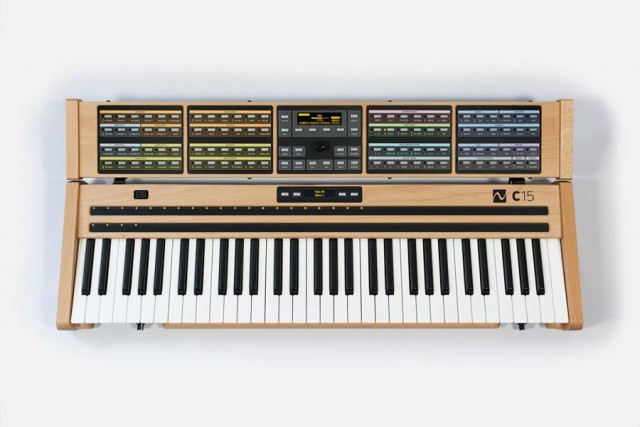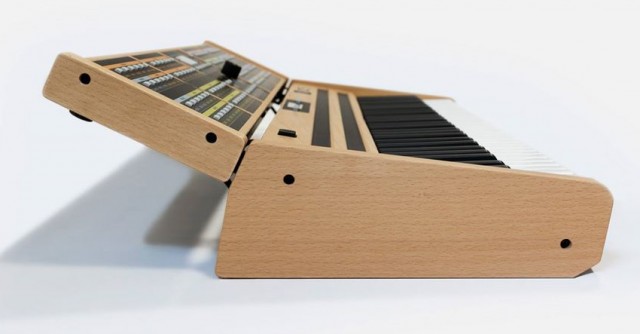Developer Stephan Schmitt (founder of Native Instruments) has shared a variety of video demos of his latest project, the Nonlinear Labs C15 Synthesizer, in action.
Here are a few examples:
Video Player
00:00
00:00
Video Player
00:00
00:00
Video Player
00:00
00:00
See the Nonlinear Labs site for a large collection of video demos. Check the text under the videos for details on the control elements used when playing the piece.
The Nonlinear Labs C15 Synthesizer is a new synth, designed around these concepts:
- Standalone systems. Self-contained synths, based on Linux systems & ARM processors. Optionally, software GUIs can be used by connecting external devices via Wi-Fi.
- Full control. They have developed the TCD musical control protocol which they say overcomes many limitations of MIDI. TCD stands for “Time, Curve, Destination” and implements a high-resolution control over all aspects of a dynamic and expressive live musical performance.
- Software-based digital sound synthesis. “Software-based” means that the durable instruments can evolve without falling into obsolescence.
- Top-quality hardware
- Open source
- Local production. Prototyping and production is carried out as locally as possible.
Pricing and Availability
A first small series of thirty units of the C15 is currently in production. It’s expected to beavailable in March. The C15 will be available to demo at Musikmesse and Superbooth. Pricing is TBA.






80’s Casio called they want their UI back…
hehe yeh first thing i thought of when i saw this GUI was my Casio CZ5000…covered in push buttons, not a knob in sight.
Must say its the only synth i dont regret selling. was a dog to program.
2017 called and they want to think of a new joke.
Sounds fantastic and looks incredible.
400 billion dollars
I can’t envision the synth world responding positively to 5 million buttons and 1 knob. But prove me wrong, Native Instruments.
The concept in itself is definitely interesting.
I know what you mean. The Synclavier II had loads of buttons and one rotary control and nobody wanted or liked that.
Yeah, but the Synclavier II didn’t sound like crap.
This is where things should go. Hell, if i could load my softsynths into a hardware controller with a configurable performance control interface and untether from a computer that would heaven! As much as hardware is the BEST thing, I can’t see being without my Omnisphere, Blue, Serum, Dune, Zebra and on & on. Existing hardware can’t lay a finger on those…but to have those reside inside something like this hardware and then being controlled by a separate hardware sequencer like the upcoming MPCs, HOLY SH*T!!!!!!!
woooooooooooo
(and NO, not like that goofy Frankenstein thing that came out of Austin, Texas in various interations this past decade or even like the Muse Research thing)
I like where this is going! Being open source means it could be ported to be other variations too.
I could see a nice all in one dj set up with one of these and the new Akai MPC X. And yes, it would be a billion two thousand dollars!
i guess i’m missing the point here, it looks great, sounds great but sometimes i dont get these offerings, especially when we’re about to be able to get a 16 voice analog for 2K, and i can only imagine what this will cost. if you’re a boutique synth nut and have endless cash to spend then i get it, it looks beautiful, but does some of the functionality get lost in the aesthetic? if I’m going to buy hardware it will be for mostly knobs and less menu diving. obviously IMO.
Why would anyone want to limit themselves to analog subtractive synthesis?
I can understand the infatuation with cheap analogs, but seriously, people should learn about synthesis.
But what form of synthesis works best with one knob? (no jokes please!) Then once you get more controls it turns into a controller keyboard for software but here the software is in the synth rather than a computer. This is why people like analogue synths, it is IC and transistors rather than another processor. This might defy logic but some people like it that way.
Still a rubbish interface, this has been around for a couple of years. Is everyone too scared to say “more controls please”? I will add that the ergonomics of row of identical buttons for on stage is terrible. I am guessing the extra panel comes off, could it be changed out for a more beknobbed one? Finally, why wood?
Really chuffed that somebody’s taking digital hardware synths seriously and making us a beautiful musical instrument that can be really played with open-ended sonic control and expressivity – fantastic!
Will there be a low priced mini-key version?
If I could wake up every morning to that first tune, I would get laid every day. I love how this thing sounds.
thanks NI for using the keybed i love, fatar tp8s ‘i hope it’s the weighted version w/aftertouch’ it’s the same action used with the ‘Virus Access ti2 keyboard 61’ one of the best synth actions on the market
The sound engine concept is solid: make a powerful digital synth that has flexibility to expand. But we kind of have that with a laptop and a controller. The hardware concept kind of makes sense, press a button, turn THE KNOB. Less immediate than, a knob per function, but more immediate than a menu dive. Looks like two ribbons above the keyboard, so there’s a couple more immediate controls. I wonder how many pedal inputs it has, maybe a BC input? Probably not.
Those kinds of sounds in the demo aren’t impossible to make with soft synths that exist. Perhaps this will have a workflow that appeals to some.
I like the concept of them re-inventing the controls internally: i.e., time, curve, destination. Time: perhaps as in LFO, envelope, etc. Curve: as in linear, exp, invert, offset, etc. etc. Destination: as in all the parameters that can be adjusted. Not so different from MIDI but perhaps more integrated. Would be nice to hear that they are doing something about the resolution– i.e. 127 steps, or 14-bit? etc.
They should hav went with another wood color. This kind of reminds me of cheap ikea bedroom wood.
Perfect for my cheap Ikea bedroom.
Why, why, why, why???????
You can get Dexed for free.
Who is their market?
Dexed is an authentic software virtual replica of the DX7 MkII (a synth that’s a mere 25+ years old and uses approximate integer maths – nothing wrong with that in itself but it has its limitations).
C15 is a physical musical instrument with expressive controls and an innovative sound engine developed using modern technology.
Their market is people who want a modern musical instrument they can play musically, interact with, and relate to in the real physical world, enabling live performances with intuitive expressive control of the an interesting and unique sound.
Modern technology, huh?
Guess MIDI is not one of them.
It’s the CZ1000 on steroids! I like the fact they are trying to do something a bit different ( that is up for debate but you know what I mean). Using Linux as well. Good on ya. We are all curious how much it will cost now.
It seems very different than the CZ range.It’s not a phase distortion synth AFAIK, and It has more emphasis on waveshaping and audio feedback paths. There are filters, but they can also sit in the feedback path to do waveguide type things. The CZ range had none of that. No filters, no feedback.
Angstrom i think he meant in GUI concept/function
Looks and sounds fabulous. However, I can’t help thinking that when the lid section is folded back over the keyboard the big knob is going to smash a hole through it.
This is not a Native Instruments product as some have mentioned in the comments. This is a product by the founder of NI but it is not a NI product
This design says one thing to me: “hey, we just realized there are consumers too young to have used this wretched control scheme the FIRST time it was popular! SHIP IT!”
‘Software-based digital sound synthesis. “Software-based” means that the durable instruments can evolve without falling into obsolescence.’
Hahahahahahahahahahahahahahahahahahahahahaha
That’s what Peavey said about their DPM(?) synth about 25 years ago
Absolutely awesome flavor of a synth, totally fresh concepts. I love it when people think beyond the standard synthesis architectures and push for something new. Wonder how much this thing will cost!
makes my solaris look quite sexy.